| Pages:
1
..
46
47
48
49
50
..
66 |
elementcollector1
International Hazard
    
Posts: 2684
Registered: 28-12-2011
Location: The Known Universe
Member Is Offline
Mood: Molten
|
|
Also, I have some magnesium powder just like that. It's very shiny, flammable (burns brightly), and doesn't state of any magnesium oxides / aluminum
oxides on the label. It was obtained from Elemental-Scientific LLC. Due to the high surface area, it should be good for this reaction, but
unfortunately the granules also look like tiny bits of potassium (making it hard to tell for me until the potassium gets bigger).
I'm fairly sure the catalyst managed to stay in the flask, as it still had that distinct aroma of tert-butanol when I turned off everything and opened
the flask.
Still, I just remembered that I didn't remember to inject 0.4mL of catalyst at reflux, instead just going with the usual 0.1mL increments. This could
contribute to loss of catalyst and potassium.
Additionally, I wonder if I could dilute the catalyst solution even further to prevent loss on the condenser (by virtue of the lamp oil's
significantly lower freezing point). The typical ratio I use is 1mL catalyst:2mL solvent, as pure catalyst always freezes on the way down. This might
not be a problem when I'm using water from a fume hood, but it certainly is when I'm using water from the outside.
Elements Collected:52/87
Latest Acquired: Cl
Next in Line: Nd
|
|
|
blogfast25
International Hazard
    
Posts: 10562
Registered: 3-2-2008
Location: Neverland
Member Is Offline
Mood: No Mood
|
|
Quote: Originally posted by elementcollector1  | | Additionally, I wonder if I could dilute the catalyst solution even further to prevent loss on the condenser (by virtue of the lamp oil's
significantly lower freezing point). The typical ratio I use is 1mL catalyst:2mL solvent, as pure catalyst always freezes on the way down. This might
not be a problem when I'm using water from a fume hood, but it certainly is when I'm using water from the outside. |
There should be no problem with that.
|
|
|
elementcollector1
International Hazard
    
Posts: 2684
Registered: 28-12-2011
Location: The Known Universe
Member Is Offline
Mood: Molten
|
|
Success?
I definitely saw something. Actually, quite a lot of somethings.
Basically, about halfway into adding catalyst (so, about half an hour after reflux) I noticed these absolutely tiny silvery bubbles that would float
to the top, and then, without popping, quickly fall back down again. I have a few reasons why they just might be potassium:
1) As per the last experiment, the magnesium significantly darkened, even when the catalyst was just starting to be added. These things were shiny
silver.
2) It was incredibly hard to tell, but they appeared to have a liquid, spherical nature - again, molten potassium.
3) They never popped, so they certainly weren't like the air bubbles that were also showing up regularly and quickly.
No pics yet, as the reaction is still going as I post this.
Elements Collected:52/87
Latest Acquired: Cl
Next in Line: Nd
|
|
|
elementcollector1
International Hazard
    
Posts: 2684
Registered: 28-12-2011
Location: The Known Universe
Member Is Offline
Mood: Molten
|
|
I hate to double post, but this is just frustrating. Took the flask and condenser off the heat plate, to find a cloudy solution, a small amount of
unreacted magnesium, and a bunch of white fluff.
If the magnesium got consumed, which it did (there was significantly less by volume inside the flask), shouldn't this reaction be working?
EDIT: Going to continue reflux for another 2 hours. Now that I think about it, what if all those granules really were K? They easily could be, given
their shiny appearance... but they could just as easily be unreacted Mg!
[Edited on 6-3-2013 by elementcollector1]
Elements Collected:52/87
Latest Acquired: Cl
Next in Line: Nd
|
|
|
condennnsa
Hazard to Others
  
Posts: 217
Registered: 20-4-2010
Location: Romania
Member Is Offline
Mood: No Mood
|
|
i bet your magnesium is the problem. to me all this evidence supports my 'magnesium poison' theory I posted farther up thread
|
|
|
blogfast25
International Hazard
    
Posts: 10562
Registered: 3-2-2008
Location: Neverland
Member Is Offline
Mood: No Mood
|
|
Quote: Originally posted by elementcollector1  | I hate to double post, but this is just frustrating. Took the flask and condenser off the heat plate, to find a cloudy solution, a small amount of
unreacted magnesium, and a bunch of white fluff.
If the magnesium got consumed, which it did (there was significantly less by volume inside the flask), shouldn't this reaction be working?
EDIT: Going to continue reflux for another 2 hours. Now that I think about it, what if all those granules really were K? They easily could be, given
their shiny appearance... but they could just as easily be unreacted Mg!
[Edited on 6-3-2013 by elementcollector1] |
You should really try and let it run its full course, at least untill you've established with certainty you've got K. Oxygen could destroy a crop of
embryonical K. Patience, EC1!
|
|
|
elementcollector1
International Hazard
    
Posts: 2684
Registered: 28-12-2011
Location: The Known Universe
Member Is Offline
Mood: Molten
|
|
Quote: Originally posted by condennnsa  | | i bet your magnesium is the problem. to me all this evidence supports my 'magnesium poison' theory I posted farther up thread |
I agree. The magnesium shavings at least reacted, darkening significantly in color. These things were untouched.
Elements Collected:52/87
Latest Acquired: Cl
Next in Line: Nd
|
|
|
blogfast25
International Hazard
    
Posts: 10562
Registered: 3-2-2008
Location: Neverland
Member Is Offline
Mood: No Mood
|
|
I see a lot of people pointing the finger at this or that but precious little documented evidence for these assertions. It's bit
like: 'I was eating pasta the other day and got a headache, ergo eating pasta causes headaches'. Not quite.
Unless someone makes a clear back-to-back comparison between an Mg that works and one that doesn't, this is all highly speculative and a potential
wild goose chase to boot.
[Edited on 6-3-2013 by blogfast25]
|
|
|
elementcollector1
International Hazard
    
Posts: 2684
Registered: 28-12-2011
Location: The Known Universe
Member Is Offline
Mood: Molten
|
|
Quote: Originally posted by blogfast25  | I see a lot of people pointing the finger at this or that but precious little documented evidence for these assertions. It's bit
like: 'I was eating pasta the other day and got a headache, ergo eating pasta causes headaches'. Not quite.
Unless someone makes a clear back-to-back comparison between an Mg that works and one that doesn't, this is all highly speculative and a potential
wild goose chase to boot.
|
Well, if you say so. My reasoning is that under the same conditions, one Mg noticeably reacted and the other didn't. My hypothesis is that one grade
of Mg is contaminated or otherwise rendered unusable. Data? 3 (5th trial as we speak) different occasions on which the Mg in question failed to react,
1 trial where the other Mg did react, darkening significantly in color.
I currently have a much-improved, ground-glass setup. Some things I added:
-A condenser with a much wider joint (due to the ground glass connection). There was an odd capillary effect with the old condenser, where liquid
would get sucked up and then remain in the bottom of the condenser's outlet tube, dripping out only occasionally. The ground glass one has a much
wider tube, removing this effect.
-Modified the catalyst mixture to be a 1:1 mix of lamp oil:alcohol, and added it all at once this time (although the sep funnel stopped working after
a while, maybe due to pressure, I was able to pipette it in).
-It's a sunny day outside! This might help with heating, and ensuring t-BuOH doesn't freeze in the condenser (though it still might, I haven't had
that problem since trial 1).
Going to run this reflux for 6 hours, and check back in on it.
My only question for this time around:
-What happens if you leave the reaction on 'too long'? Could the potassium get destroyed again by incoming water vapor or oxygen, or would it stay
under the lamp oil? (I suppose that depends on density.)
Elements Collected:52/87
Latest Acquired: Cl
Next in Line: Nd
|
|
|
Mailinmypocket
International Hazard
    
Posts: 1351
Registered: 12-5-2011
Member Is Offline
Mood: No Mood
|
|
Okay, let's compare results and see what happens. Obviously we have different grades and types of Mg and solvents, but if we run the exact same
quantities of reagents etc it might shed some light on what makes this reaction tick, or not. Are you still using the proportions of reagents you
mentioned up-thread? I will run this tomorrow, following the original procedure as closely as possible, and adding all of the t-BuOH catalyst in the
beginning as opposed to dosed additions.
I am thinking its either the Mg surface area or amount of catalyst. KOH is pretty invariable, so is the solvent... As long as it satisfies the same
properties as Shelsol etc it should be okay. I have kept a sample of commercial K under lamp oil for months with no degradation so far, the oil
obviously doesn't react with the K to an extent that is obvious. I may pass argon through the system, but then again, I don't think it is all that
necessary given that nobody else has had to do it
|
|
|
elementcollector1
International Hazard
    
Posts: 2684
Registered: 28-12-2011
Location: The Known Universe
Member Is Offline
Mood: Molten
|
|
No pictures, unfortunately. Rest assured I let this thing go for 6 hours.
This time, I added all the catalyst at once. Nothing.
Also, apparently that 1:1 ratio of catalyst to solvent wasn't good: some alcohol noticeably froze in the condenser.
Oddly, the Mg seemed to react in this one, but it simply disappeared, possibly into the white, sludgy mix. Or it's hidden inside.
If I do a next run (I'm about ready to give up after 5 tries in a row), I'll probably make sure everything is EXTRA dry, and do this inside.
Talked to my Science Club about this, and the coach said this might be due to the lamp oil boiling before 200 C.
I had an idea: What if one makes K-tert-butoxide, dries this, and reacts this with magnesium? Wouldn't this skip the intermediary KOH step?
Elements Collected:52/87
Latest Acquired: Cl
Next in Line: Nd
|
|
|
blogfast25
International Hazard
    
Posts: 10562
Registered: 3-2-2008
Location: Neverland
Member Is Offline
Mood: No Mood
|
|
KO t-Bu (potassium t-butoxide) is hard to make from KOH. And you need a whole lot more t-butanol to pull it off. There's an example in the patent,
using a t-butoxide.
I'm baffled by these fails... 
[Edited on 9-3-2013 by blogfast25]
|
|
|
elementcollector1
International Hazard
    
Posts: 2684
Registered: 28-12-2011
Location: The Known Universe
Member Is Offline
Mood: Molten
|
|
So am I. I'll have to do a check of everything to make sure everything is what it says it is. So far:
-KOH was proven to be KOH (precipitated Cr(OH)3 from K-alum upon boiling). Experiment by flame test, just to check?
-Mg powder was proven to be flammable and reactive, at least upon ignition (earlier experiment with MnO2 and Mg. Failed that thermite too.)
-t-BuOH was proven to be t-BuOH by freezing point (and I trust Mailinmypocket anyway).
-Lamp oil is still a bit unknown. Boiling point could be above or below 200 C, and parents refuse to give me thermometer. Ideas?
-Hot plate can reach 200 C, as evidenced by decomposing MgSO4.7H2O to the anhydrate.
-Glassware is secure, as is aluminum foil.
-Sand bath is working fine, as is condenser flow (although I think I might have overdid it on the last run...)
Elements Collected:52/87
Latest Acquired: Cl
Next in Line: Nd
|
|
|
Mailinmypocket
International Hazard
    
Posts: 1351
Registered: 12-5-2011
Member Is Offline
Mood: No Mood
|
|
Here we go again!
Alright- so I just started the reaction, using the same amounts of reagents as Pok, sandbath and damp filter paper user to cool the glass tube
condenser. I decided to add all the t-BuOH at once before heating, just to switch things up a bit. About 20 minutes after heating there was the usual
white fumes, and now there are about 30 very small K balls buzzing around. I'm not excited about it though since this has happened almost every time.
Ill report back on the outcome in a few hours, we shall see!
If it doesn't work then it is either my Mg or the baby oil (the same one nurdrage shows in his video- did he actually try it!?) If this attempt fails
I will go to work and get some tetralin, if that fails then the Mg is apparently the problem.
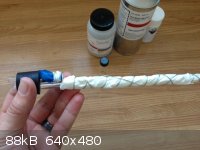 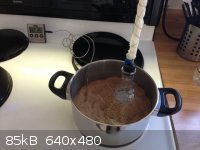
|
|
|
elementcollector1
International Hazard
    
Posts: 2684
Registered: 28-12-2011
Location: The Known Universe
Member Is Offline
Mood: Molten
|
|
So am I. I'll have to do a check of everything to make sure everything is what it says it is. So far:
-KOH was proven to be KOH (precipitated Cr(OH)3 from K-alum upon boiling). Experiment by flame test, just to check?
-Mg powder was proven to be flammable and reactive, at least upon ignition (earlier experiment with MnO2 and Mg. Failed that thermite too.)
-t-BuOH was proven to be t-BuOH by freezing point (and I trust Mailinmypocket anyway).
-Lamp oil is still a bit unknown. Boiling point could be above or below 200 C, and parents refuse to give me thermometer. Ideas?
-Hot plate can reach 200 C, as evidenced by decomposing MgSO4.7H2O to the anhydrate.
-Glassware is secure, as is aluminum foil.
-Sand bath is working fine, as is condenser flow (although I think I might have overdid it on the last run...)
Elements Collected:52/87
Latest Acquired: Cl
Next in Line: Nd
|
|
|
elementcollector1
International Hazard
    
Posts: 2684
Registered: 28-12-2011
Location: The Known Universe
Member Is Offline
Mood: Molten
|
|
Quote: Originally posted by Mailinmypocket  | Alright- so I just started the reaction, using the same amounts of reagents as Pok, sandbath and damp filter paper user to cool the glass tube
condenser. I decided to add all the t-BuOH at once before heating, just to switch things up a bit. About 20 minutes after heating there was the usual
white fumes, and now there are about 30 very small K balls buzzing around. I'm not excited about it though since this has happened almost every time.
Ill report back on the outcome in a few hours, we shall see!
If it doesn't work then it is either my Mg or the baby oil (the same one nurdrage shows in his video- did he actually try it!?) If this attempt fails
I will go to work and get some tetralin, if that fails then the Mg is apparently the problem.
|
Hold the freakin phone. You added the alcohol before any heating? That's... actually a pretty good idea.
I always waited until reflux. Also, this might be too late (didn't check your post time), but swirl the flask a bit, maybe it'll coalesce all those
K-balls into a larger, more-resistant-to-attack one.
Elements Collected:52/87
Latest Acquired: Cl
Next in Line: Nd
|
|
|
Mailinmypocket
International Hazard
    
Posts: 1351
Registered: 12-5-2011
Member Is Offline
Mood: No Mood
|
|
Quote: Originally posted by elementcollector1  | Quote: Originally posted by Mailinmypocket  | Alright- so I just started the reaction, using the same amounts of reagents as Pok, sandbath and damp filter paper user to cool the glass tube
condenser. I decided to add all the t-BuOH at once before heating, just to switch things up a bit. About 20 minutes after heating there was the usual
white fumes, and now there are about 30 very small K balls buzzing around. I'm not excited about it though since this has happened almost every time.
Ill report back on the outcome in a few hours, we shall see!
If it doesn't work then it is either my Mg or the baby oil (the same one nurdrage shows in his video- did he actually try it!?) If this attempt fails
I will go to work and get some tetralin, if that fails then the Mg is apparently the problem.
|
Hold the freakin phone. You added the alcohol before any heating? That's... actually a pretty good idea.
I always waited until reflux. Also, this might be too late (didn't check your post time), but swirl the flask a bit, maybe it'll coalesce all those
K-balls into a larger, more-resistant-to-attack one. |
It's actually Blogfast that originally did the "one pot" reaction and had success, otherwise the times addition seems to be the norm, but I'm just
playing with different variables right now to see what happens! The t-butanol I sent you is indeed not the problem, it's reagent grade from a
supplier. I just swirled the flask a bit now, little micro balls are present but no major changes. Time to have a beer and visit the flask later and
see how things are going  what lamp oil are you using? Maybe we can find an MSDS
or something... what lamp oil are you using? Maybe we can find an MSDS
or something...
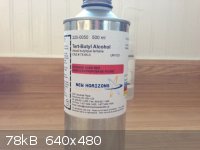
Edit- Okay, well, the odor of failure is strong in the air. Again. I'm faily convinced at this point that the Mg is the culprit. Despite it being
reagent grade blah blah blah, it's too coarse, not enough surface area is present. This may explain why at first I always see K, and it then
disappears. At first, enough fresh Mg is exposed to drive the system forward, however once the surfaces react things start going backwards due to an
excess of catalyst that can't react with any fresh Mg. there is enough Mg, just not in the right form.
That's my crude theory anyways... Ill let it go 4 hours but I'm sure nothing will become of it.
[Edited on 9-3-2013 by Mailinmypocket]
|
|
|
blogfast25
International Hazard
    
Posts: 10562
Registered: 3-2-2008
Location: Neverland
Member Is Offline
Mood: No Mood
|
|
Quote: Originally posted by Mailinmypocket  | . I just swirled the flask a bit now, little micro balls are present but no major changes. Time to have a beer and visit the flask later and see how
things are going  what lamp oil are you using? Maybe we can find an MSDS or
something... what lamp oil are you using? Maybe we can find an MSDS or
something...
[Edited on 9-3-2013 by Mailinmypocket] |
From micro balls, mighty balls of K grow. Initially, the K is indeed a fine dispersion in the rest. And it takes 2h or more to get reasonable size K
globules.
Nurdrage also used 'one pot' a few times and it worked. He did claim to see more variability in the results. Personally, going by the assumed reaction
path, I can't see why adding the catalyst all at once and before heating would make any difference at all (compared to the hocus pocus 'timed
addition'). So I tried one pot and it worked just the same...
EC1: I really would invest in a temperature probe: temperature has a strong effect on most reaction speeds. It appears to be the one thing you're not
controlling as most of us do or try...
[Edited on 9-3-2013 by blogfast25]
|
|
|
Mailinmypocket
International Hazard
    
Posts: 1351
Registered: 12-5-2011
Member Is Offline
Mood: No Mood
|
|
Ah, you posted before I finished editing the last post! Actually... No K is visible anymore... I'm sure the Mg is the problem
|
|
|
blogfast25
International Hazard
    
Posts: 10562
Registered: 3-2-2008
Location: Neverland
Member Is Offline
Mood: No Mood
|
|
If K really formed, then disappeared how do you arrive at the conclusion that the Mg is at fault? Bear in mind that others have had trouble with
powdered Mg too and that my own Mg powder is only as fine as sand.
[Edited on 9-3-2013 by blogfast25]
|
|
|
Mailinmypocket
International Hazard
    
Posts: 1351
Registered: 12-5-2011
Member Is Offline
Mood: No Mood
|
|
Quote: Originally posted by blogfast25  |
If K really formed, then disappeared how do you arrive at the conclusion that the Mg is at fault? Bear in mind that others have had trouble with
powdered Mg too and that my own Mg powder is only as fine as sand.
[Edited on 9-3-2013 by blogfast25] |
Well, I'm just blaming the Mg since it is the only reactant that I have had problems with since the start. At first it was that Ca, Mg oxide coated
shit, and then grignard turnings that are more like thick chips of Mg. I don't see why the solvent is the issue, I have had small bits of commercial K
stored under both baby oil and lamp oil for almost 3 months now, no major changes in appearance. Unless something is happening at the solvent/catalyst
level I am not aware of...
The KOH has been varied, from technical grade flakes to ACS pellets, nada difference. It appears as though ever since using the recent Mg I always get
small K at first and it disappears, everything else has been the same as far as temperature, solvents(tried 3).
I can't say for sure that the Mg is the problem, I'm just leaning towards that conclusion really...
[Edited on 9-3-2013 by Mailinmypocket]
|
|
|
elementcollector1
International Hazard
    
Posts: 2684
Registered: 28-12-2011
Location: The Known Universe
Member Is Offline
Mood: Molten
|
|
What about catalyst? What comes to mind is that the K forms, but when the Mg runs out the catalyst turns right around and starts consuming the K
metal.
Elements Collected:52/87
Latest Acquired: Cl
Next in Line: Nd
|
|
|
elementcollector1
International Hazard
    
Posts: 2684
Registered: 28-12-2011
Location: The Known Universe
Member Is Offline
Mood: Molten
|
|
I've attempted using 2:
"Nowell's Lamp Oil":
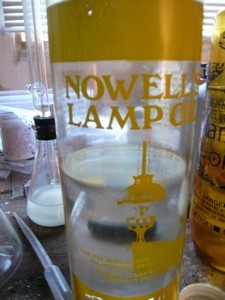
"Sunnyside Crystal Lamp Oil":
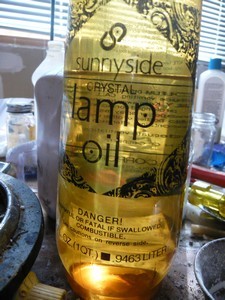
Elements Collected:52/87
Latest Acquired: Cl
Next in Line: Nd
|
|
|
Mailinmypocket
International Hazard
    
Posts: 1351
Registered: 12-5-2011
Member Is Offline
Mood: No Mood
|
|
Quote: Originally posted by elementcollector1  | | What about catalyst? What comes to mind is that the K forms, but when the Mg runs out the catalyst turns right around and starts consuming the K
metal. |
My thoughts exactly. Then again, I could be very wrong, the Mg coarseness is what I am going to try to tackle first. I really wish I could send
samples of my solvent, Mg and catalyst to everyone interested and we could all compare results. Anyways, no K today, only crusty crap and confusion,
the usual result of K synthesis around here. I have a feeling that having many fresh surfaces of Mg makes the difference between the reaction
working... Or not. It's true that other variables are in play, but for now I blame the Mg.
The last picture of lamp oil looks almost exactly like mine except rebranded! Anyhow, here is my lunar landscape of oxide, frustration and cursing
 the end result of a reaction doomed from the start I am sure. the end result of a reaction doomed from the start I am sure.
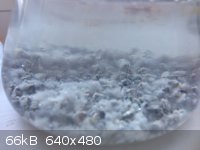
[Edited on 9-3-2013 by Mailinmypocket]
|
|
|
elementcollector1
International Hazard
    
Posts: 2684
Registered: 28-12-2011
Location: The Known Universe
Member Is Offline
Mood: Molten
|
|
It looks like some potassium is still in there, judging by a close-up. Or is that magnesium?
Elements Collected:52/87
Latest Acquired: Cl
Next in Line: Nd
|
|
|
| Pages:
1
..
46
47
48
49
50
..
66 |